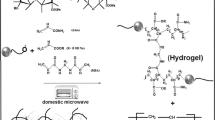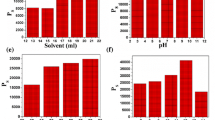Abstract
In this study, the synthesis and characterization of a novel nano-porous superabsorbent hydrogel with high water swelling capacity is described. A nano-porous hydrogel was prepared by employing (2-dimethylaminoethyl) methacrylate (PDMAEMA) as a pH sensitive monomer and sodium alginate (SA) as a water soluble polysaccharide under γ-ray irradiation. The polymerization reaction was performed at room temperature in the absence of chemically toxic crosslinking agent and initiators. The interactive parameters including biopolymer backbone concentration, monomer concentration and γ-irradiation dose were selected as major factors in the synthesis of superabsorbent and three levels for each factor were applied to obtain the highest water swelling according to the central composite design (CCD) method. According to the results of nine different tests which were derived by CCD method, the optimum conditions were determined. The results showed that the hydrogel prepared at concentration of 1.5 g SA, 2.1 mol/L PDMAEMA and at a radiation dose of 5 kGy displayed the highest swelling capacity. In continuation, the effect of salt, pH, and particle size on the swelling behavior of the obtained samples was investigated. We found that the swelling of the optimized sample first increased and then dropped with increases in pH from 2 to 12 and the maximum water absorbency was observed at pH 7. Finally, different techniques such as Fourier transform infrared spectroscopy (FTIR), thermogravimetric analysis (TGA) and scanning electron microscope (SEM) were applied for the characterization of optimized nano-porous hydrogel.










Similar content being viewed by others
References
Alcantara MTS, Brant AJC, Giannini DR, Pessoa JOCP, Andrade AB, Riella HG, Lugao AB (2012) Influence of dissolution processing of PVA blends on the characteristics of their hydrogels synthesized by radiation. Part I: gel fraction, swelling, and mechanical properties. Radiat Phys Chem 81:1465–1470
Zhou C, Li P, Qi X, Sharif ARM, Poon YF, Cao Y, Chang MW, Leong SSJ, Chan-Park MB (2011) A photopolymerized antimicrobial hydrogel coating derived from epsilon-poly-l-lysine. Biomaterials 32:2704–2712
Jha PK, Jha R, Gupta BL, Guha SK (2010) Effect of γ-dose rate and total dose interrelation on the polymeric hydrogel: a novel injectable male contraceptive. Radiat Phys Chem 79:663–671
Turturro SB, Guthrie MJ, Appel AA, Drapala PW, Brey EM, Pérez-Luna VH, Mieler WF, Kang-Mieler JJ (2011) The effects of cross-linked thermo-responsive PNIPAAm-based hydrogel injection on retinal function. Biomaterials 32:3620–3626
Raafat AI, Araby E, Lotfy S (2012) Enhancement of fibrinolytic enzyme production from Bacillus subtilis via immobilization process onto radiation synthesized starch/dimethylaminoethyl methacrylate hydrogel. Carbohydr Polym 87:1369–1374
Zuidema JM, Pap MM, Jaroch DB, Morrison FA, Gilbert RJ (2011) Fabrication and characterization of tunable polysaccharide hydrogel blends for neural repair. Acta Biomater 7:1634–1643
Yang C, Xu L, Zhou Y, Zhang X, Huang X, Wang M, Han Y, Zhai M, Wei S (2010) A green fabrication approach of gelatin/CM-chitosan hybrid hydrogel for wound healing. Carbohydr Polym 82:1297–1305
LoPresti C, Vetri V, Ricca M, Foderà V, Tripodo G, Spadaro G, Dispenza C (2011) Pulsatile protein release and protection using radiation-crosslinked polypeptide hydrogel delivery devices. React Funct Polym 71:155–167
Nizam El-Din HM, AbdAlla SG, El-Naggar AWM (2010) Swelling and drug release properties of acrylamide/carboxymethyl cellulose networks formed by gamma irradiation. Radiat Phys Chem 79:725–730
Khodja AN, Mahlous M, Tahtat D, Benamer S, Youcef SL, Chader H, Mouhoub L, Sedgelmaci M, Ammi N, Mansouri MB, Mameri S (2012) Evaluation of healing activity of PVA/chitosan hydrogels on deep second degree burn: pharmacological and toxicological tests. Burns (in press)
Ramseyer P, Micol LA, Engelhardt E, Osterheld M, Hubbell JA, Frey P (2010) In vivo study of an injectable poly(acrylonitrile)-based hydrogel paste as a bulking agent for the treatment of urinary incontinence. Biomaterials 31:4613–4619
Soler DM, Rodríguez Y, Correa H, Moreno A, Carrizales L (2012) Pilot scale-up and shelf stability of hydrogel wound dressings obtained by gamma radiation. Radiat Phys Chem 81:1249–1253
Park J, Kim H, Choi J, Gwon H, Shin Y, Lim Y, Khil MS, Nho Y (2012) Effects of annealing and the addition of PEG on the PVA based hydrogel by gamma ray. Radiat Phys Chem 81:857–860
Oliveira MJA, Parra DF, Amato VS, Lugão AB (2012) Hydrogel membranes of PVAI/clay by gamma radiation. Radiat Phys Chem (in press)
Bardajee GR, Pourjavadi A, Sheikh N, Amini-Fazl MS (2008) Grafting of acrylamide onto kappa-carrageenan via gamma-irradiation: optimization and swelling behavior. Radiat Phys Chem 77:131–137
Pourjavadi A, Barzegar S, Zeidabadi F (2007) Synthesis and properties of biodegradable hydrogels of kappa-carrageenan grafted acrylic acid-co-2-acrylamido-2-methylpropanesulfonic acid as candidates for drug delivery systems. React Funct Polym 67:644–654
Choi J, Kim J, Srinivasan P, Kim J, Park H, Byun M, Lee J (2009) Comparison of gamma ray and electron beam irradiation on extraction yield, morphological and antioxidant properties of polysaccharides from tamarind seed. Radiat Phys Chem 78:605–609
Sokker HH, El-Sawy NM, Hassan MA, El-Anadouli BE (2011) Adsorption of crude oil from aqueous solution by hydrogel of chitosan based polyacrylamide prepared by radiation induced graft polymerization. J Hazard Mater 190:359–365
Jipa IM, Stroescu M, Stoica-Guzun A, Dobre T, Jinga S, Zaharescu T (2012) Effect of gamma irradiation on biopolymer composite films of poly(vinyl alcohol) and bacterial cellulose. Nucl Inst Method Phys Res Sect B 278:82–87
Wang D, Hill DJT, Rasoul F, Whittaker AK (2011) A study of the swelling and model protein release behaviours of radiation-formed poly(N-vinyl 2-pyrrolidone-co-acrylic acid) hydrogels. Radiat Phys Chem 80:207–212
Tan R, She Z, Wang M, Fang Z, Liu Y, Feng Q (2012) Thermo-sensitive alginate-based injectable hydrogel for tissue engineering. Carbohydr Polym 87:1515–1521
Wang Q, Xie X, Zhang X, Zhang J, Wang A (2010) Preparation and swelling properties of pH-sensitive composite hydrogel beads based on chitosan-g-poly(acrylic acid)/vermiculite and sodium alginate for diclofenac controlled release. Int J Biol Macromol 46:356–362
Hunt NC, Smith AM, Gbureck U, Shelton RM, Grover LM (2010) Encapsulation of fibroblasts causes accelerated alginate hydrogel degradation. Acta Biomater 6:3649–3656
Liu Y, Yang L, Li J, Shi Z (2005) Grafting of methyl methacrylate onto sodium alginate initiated by potassium ditelluratoargentate (III). J Appl Polym Sci 97:1688–1694
Zha L, Hu J, Wang C, Hu S, Elaissari A, Zhang Y (2002) Preparation and characterization of poly(N-isopropylacrylamide-co-dimethylaminoethyl methacrylate) microgel latexes. Colloid Polym Sci 280:1–6
Traitel T, Cohen Y, Kost J (2000) Characterization of glucose-sensitive insulin release systems in simulated in vivo conditions. Biomaterials 21:1679–1687
Basan H, Gümüsderelíoglu M, Orbey T (2002) Diclofenac sodium releasing pH-sensitive monolithic devices. Int J Pharm 245:191–198
Vande-Wetering P, Schuurmans-Nieuwenbroek NME, Van Steenbergen MJ, Crommelin DJA, Hennink WE (2000) Copolymers of 2-(dimethylamino) ethyl methacrylate with ethoxytriethylene glycol methacrylate or N-vinyl-pyrrolidone as gene transfer agents. J Control Release 64:193–203
Kurisawa M, Yokoyama M, Okano T (2000) Gene expression control by temperature with thermo-responsive polymeric gene carriers. J Control Release 69:127–137
Uzun C, Hassnisaber M, Sen M, Guven O (2003) Enhancement and control of cross-linking of dimethylaminoethyl methacrylate irradiated at low dose rate in the presence of ethylene glycol dimethacrylate. Nucl Inst Method Phys Res Sect B 208:242–246
Sen M, Sarı M (2005) Radiation synthesis and characterization of poly(N, N-dimethylaminoethyl methacrylate-co-N-vinyl2-pyrrolidone) hydrogels. Eur Polym J 41:1304–1314
Author information
Authors and Affiliations
Corresponding author
Rights and permissions
About this article
Cite this article
Bardajee, G.R., Hooshyar, Z., Zehtabi, F. et al. A superabsorbent hydrogel network based on poly((2-dimethylaminoethyl) methacrylate) and sodium alginate obtained by γ-radiation: synthesis and characterization. Iran Polym J 21, 829–836 (2012). https://doi.org/10.1007/s13726-012-0089-z
Received:
Accepted:
Published:
Issue Date:
DOI: https://doi.org/10.1007/s13726-012-0089-z




